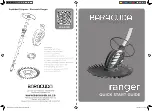
10 For Professional Technical Support call 1-844-241-5521
:
Risk of explosion.
Before removing trap cover:
:
NEVER run pump dry. Running pump dry may damage seals, causing leakage and flooding. Fill pump
with water before
starting motor.
1.
Stop pump
before proceeding.
2.
Close gate valves
in suction and discharge pipes.
3.
Release all pressure
from pump and piping system.
4. If pump is being pressure tested, be sure pressure has been released before removing trap cover.
:
Risk of fire and burns
. Motors run at high temperatures. To reduce the risk of fire, do not allow leaves, debris, or
foreign matter to collect around the pump motor. To avoid burns when handling the motor, let it cool for 20 minutes before trying to
work on it. An automatic internal cut off switch protects the motor from heat damage during operation.
Priming Pump
Release all pressure from filter, pump, and piping
system; see the filter owner’s manual.
In a flooded suction system (water source higher than
pump), pump will prime itself when suction and
discharge valves are opened.
If pump is not in a flooded suction system, unscrew and remove trap cover; fill trap and pump with
water. Do not lubricate the trap cover O-ring. The original equipment O-ring contains a permanent
internal lubricant.
:
If you replace the O-ring with a non-internally lubricated O-ring, you may need to apply a silicone based lubricant.
Clean and inspect O-ring; reinstall on trap cover. Replace trap cover on trap; turn clockwise to tighten cover.
:
Tighten trap cover by hand only (no wrenches)! Pump should prime now. Priming time will depend on vertical length of
suction lift and horizontal length of suction piping.
If pump does not prime within three minutes, make sure that all valves are open, suction pipe end is under water, pump is not trying to lift water more
than 10 ft. (3 m), and that there are no leaks in suction pipe. If necessary, see Troubleshooting.
Storage/Winterizing:
:
Allowing pump to freeze will damage pump and void warranty!
:
Do not use anti-freeze solutions (except propylene glycol) in your pool/spa system. Propylene glycol, or “RV antifreeze”, is
non-toxic and will not damage plastic system components; other anti-freeze formulas are highly toxic and may damage plastic
components in the system.
Drain all water from pump and piping when expecting freezing temperatures or when storing pump for a long time (see Draining Pump).
Keep motor dry and covered during storage.
To avoid condensation/corrosion problems, do not cover pump with plastic.
For outdoor/unprotected installations:
1.
Enclose entire system in a weather proof enclosure.
2.
To avoid condensation/corrosion damage, allow ventilation; do not wrap system in plastic.
3.
Use a 40% propylene glycol/60% water solution to protect pump to -50° F (-46° C).
Содержание SPP15002
Страница 15: ......
Страница 16: ...1 844 241 5521 HOMEDEPOT COM ...


































